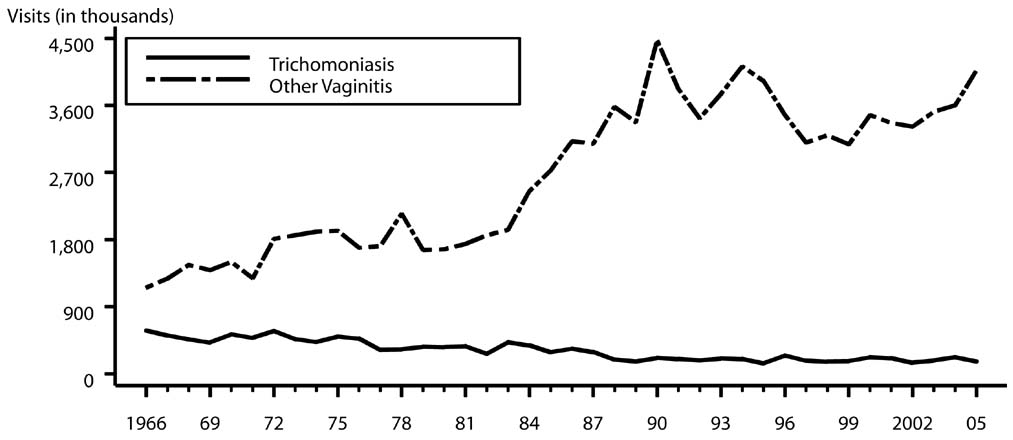Trichomoniasis epidemiology and demographics
|
Trichomoniasis Microchapters |
|
Diagnosis |
|
Treatment |
|
Case Studies |
|
Trichomoniasis epidemiology and demographics On the Web |
|
American Roentgen Ray Society Images of Trichomoniasis epidemiology and demographics |
|
Risk calculators and risk factors for Trichomoniasis epidemiology and demographics |
Editor-In-Chief: C. Michael Gibson, M.S., M.D. [1]; Associate Editor(s)-in-Chief: Maliha Shakil, M.D. [2], Aysha Anwar, M.B.B.S[3]
Overview
Trichomoniasis is the most common curable STD in young, sexually active women. An estimated 7.4 million new cases occur each year in the United States. In 2008, the incidence of trichomoniasis was estimated to be 358 cases per 100,000 individuals in the United States.[1] Females are more commonly affected with trichomoniasis than males.[2] Trichomoniasis usually affects African American individuals. Caucasian individuals are less likely to develop trichomoniasis. In the United States, the highest prevalence of trichomonas infection in women is seen among African-Americans, with rates ranging from 13–51%.[3]
Epidemiology and Demographics
The worldwide incidence and prevalence of trichomoniasis is reflected in the following table:[4]
| Region | Gender | Incidence/100,000/yr | Prevalence/100,000 |
|---|---|---|---|
| Africa | M | 16,500 | 2000 |
| F | 14,600 | 20,200 | |
| The Americas | M | 1,806 | 2,200 |
| F | 17,700 | 22,000 | |
| South East Asia | M | 5,000 | 600 |
| F | 4,030 | 5,600 | |
| Europe | M | 4,840 | 600 |
| F | 5,170 | 5,800 | |
| East Mediterranean | M | 6,600 | 800 |
| F | 6,400 | 8000 | |
| Western Pacific region includes China and Australia | M | 4,700 | 600 |
| F | 4,600 | 5,700 | |
| United States of America[1] | F | 358 | 310 |
Prevalence in United States of America
The prevalence of trichomonasis in the United States between 1966 and 2005 is reflected in the graph below:

Trichomoniasis and other vaginal infections in women — Initial visits to physicians' offices: United States, 1966–2005:[5][6]
Demographic factors
The following demographic factors may affect incidence and prevalence of trichomoniasis:
Age
Trichomoniasis occurs most commonly among women aged 20-45 years.[7]
Gender
Females are more commonly affected by trichomoniasis than males.[2]
Race
Trichomoniasis usually affects African American individuals. Caucasian individuals are less likely to develop trichomoniasis. In the United States, the highest prevalence of trichomonas infection in women is observed among African-Americans, with rates ranging from 13–51%.[3]
References
- ↑ 1.0 1.1 Incidence, Prevalence, and Cost of Sexually Transmitted Infections in the United States. CDC.http://www.cdc.gov/std/stats/sti-estimates-fact-sheet-feb-2013.pdf Accessed on February 2, 2016
- ↑ 2.0 2.1 Trichomoniasis Statistics. CDC.http://www.cdc.gov/std/trichomonas/stats.htm Accessed on January 26, 2016
- ↑ 3.0 3.1 Kissinger P (2015). "Trichomonas vaginalis: a review of epidemiologic, clinical and treatment issues". BMC Infect Dis. 15: 307. doi:10.1186/s12879-015-1055-0. PMC 4525749. PMID 26242185.
- ↑ http://apps.who.int/iris/bitstream/10665/75181/1/9789241503839_eng.pdf
- ↑ "STD Facts - Trichomoniasis". Retrieved 2012-12-27.
- ↑ "DPDx - Trichomoniasis". Retrieved 2012-12-27.
- ↑ Petrin D, Delgaty K, Bhatt R, Garber G (1998). "Clinical and microbiological aspects of Trichomonas vaginalis". Clin Microbiol Rev. 11 (2): 300–17. PMC 106834. PMID 9564565.